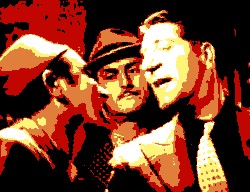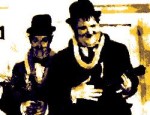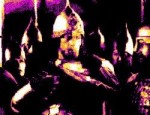Film Review

Jean Renoir was originally approached to direct Pépé le Moko, an adaptation of a novel of the same title by Henri La Barthe (alias Ashelbé), but he declined and the producers (the famous Hakim brothers) gave the job to Julien Duvivier, who had recently established himself as one of France's leading filmmakers. Duvivier had the opportunity to shoot most of the film on location in Algiers, but he instead opted to recreate the Algerian Casbah in the Pathé Cinéma studios in Paris. He did this for artistic rather than budgetary reasons, so that he would have complete control over the lighting and thereby achieve precisely the atmosphere he intended for the film. The impressive art design was overseen by Robert Vernay, who would subsequently become a film director of some distinction, helming such prestigious period productions as Le Comte de Monte Cristo (1943) and Le Capitan (1946). There are a few exterior sequences, but these were shot in France, at Marseilles and Sète. The film's beautifully expressive film noir look was created by the gifted cinematographer Jules Kruger, whose previous credits include such masterworks as Abel Gance's Napoléon (1927), Marcel Lherbier's L'Argent (1928) and Raymond Bernard's Les Croix de bois (1932). Kruger's work is complemented by the film's memorable score, which offers a haunting evocation of the exotic Mediterranean setting overlaid with a chilling sensation of inescapable doom. Together, the lighting and the music convey an oppressive sense of a world in turmoil, where the forces of darkness and light are locked in perpetual conflict - a potent metaphor for man's eternal struggle against earthly torment and death.
Revelling in his most iconic role is Jean Gabin, his fifth collaboration with Julien Duvivier after Maria Chapdelaine (1934), Golgotha (1935), La Bandera (1935) and La Belle équipe (1936). The part of Pépé le Moko, the king of the Algerian underworld (Moko being a slang word meaning from Marseilles), appears to have been tailor-made for Gabin and it is hard to imagine any other French actor of the period bringing as much passion, charm and pathos to the role. Gabin's amiable working class persona and charisma made him the perfect choice for the role of the doomed romantic hero. Whether he is cast as the hardened gangster or as a cynical deserter, he compels us to sympathise with him and see the world through his eyes, to share his dreams and feel his despair as these dreams turn to dust. Gabin's natural flair for playing likeable mavericks with panache and authority is what made him an overnight star and earned him his status as one of the great icons of French cinema. It is in Pépé le Moko that Gabin gives one of his greatest performances, a captivating tour de force. He even gets to show off his talent as a chansonnier, crooning a romantic ballad that became a notable hit in France.
Whilst Pépé le Moko is dominated by Jean Gabin's forceful presence, it is not possible to overlook the contributions from his talented co-stars. In her first major screen role, Mireille Balin makes a stunning femme fatale and has an ethereal presence in the film, strangely detached from the sordid reality in which the hero and his entourage exist. Line Noro is just as eye-catching as Pépé's neglected mistress, viciously assailing our heartstrings with her portrayal of the jilted lover who is ultimately consumed by bitterness and envy. As the deliciously villainous Inspector Slimane Lucas Gridoux proves to be a crafty little scene stealer, exuding the quiet menace and sinister intent of a neo-fascist traffic warden who has just spotted a 4x4 parked on a double yellow line. Had the film been made just a few years later, Gridoux would doubtless have been seen as the epitome of the Vichy government official, festering nausea-inducing green slime in human form.
As if this was not enough, the supporting cast includes some very distinguished French character actors - Fernand Charpin, Marcel Dalio, Gabriel Gabrio, Saturnin Fabre and Gaston Modot - all of whom add something to the film's rich texture and authenticity. The sequence in which Charpin's character (another dollop of green slime) is executed provides the film with one of its dramatic highpoints, the intense primal savagery of the killing emphasised by some harshly expressionistic lighting and the cacophony of a mechanical piano. Cast-wise, the icing on the cake is the presence of the popular musical hall singer Fréhel, who manages to steal the show completely in the film's most moving scene, the one where she and Gabin quietly reflect on their lost past whilst she solemnly intones the words of one of her own songs Où est-il donc? played on a gramophone. This scene, so poignant and humane, encapsulates the essence of film noir - characters trapped in a seedy milieu from which there is no hope of escape. The freedom and future happiness that Gabin and Fréhel dream of will be forever beyond their grasp - just as it is for every human being. Pépé le Moko is not so much a gangster film as a cruel statement of truth, that in the real world no one lives happily ever after.
When it was re-released after the war, Pépé le Moko was widely recognised as a major cinematic achievement. It was untarnished when the French press (including the critics on the Cahiers du cinéma) laid into Julien Duvivier towards the end of his career and is considered today one of the landmarks of 1930s French cinema. On the back of its international success, Hollywood delivered two obvious remakes, the first titled Algiers (1938), directed by John Cromwell and starring Charles Boyer and Hedy Lamarr. The second remake, Casbah (1948), was directed by John Berry and starred Tony Martin, Yvonne De Carlo and Peter Lorre. The film also inspired an outlandish spoof entitled Totò le Moko (1951), which featured the legendary Italian comic Totò. Needless to say, none of these imitations can hold a candle to Duvivier's timeless classic, which is assuredly one of the darkest and most stylish French films of the 1930s - French film noir at its most vivid and intoxicating.
© James Travers 2002
The above content is owned by frenchfilms.org and must not be copied.
Film Synopsis
The French outlaw Pépé le Moko has gained a reputation as the most notorious gangster in Algiers, loyally served by his band of armed cohorts. The police are determined to bring him to book, but every attempt so far to lure him out of the Casbah where he is safely in hiding has failed. Assisted by an informer named Régis and using the gangster's favoured protégé as bait, Inspector Slimane lays a trap which he is certain will draw Pépé into the open and allow him to be arrested. Unaware of these machinations, Pépé makes the acquaintance of a glamorous Parisian tourist, Gaby Gould, who instantly awakens in him a desire to return to his native France. Aware that Pépé is losing his heart to Gaby, the gangster's faithful mistress Inès becomes jealous - jealous enough to betray him to his enemies...© James Travers
The above content is owned by frenchfilms.org and must not be copied.
Similar Films
Here are some other films you may enjoy watching:- Les Amours de minuit (1931)
- Impact (1949)
- Une manche et la belle (1957)
- They Live by Night (1948)
- La Bête à l'affût (1959)
Other related links:
Film Credits
- Director: Julien Duvivier
- Script: Julien Duvivier, Henri La Barthe (novel), Jacques Constant, Henri Jeanson (dialogue)
- Cinematographer: Marc Fossard, Jules Kruger
- Music: Vincent Scotto, Mohamed Ygerbuchen
- Cast: Jean Gabin (Pépé le Moko), Gabriel Gabrio (Carlos), Saturnin Fabre (Le Grand Père), Fernand Charpin (Régis), Lucas Gridoux (Inspecteur Slimane), Gilbert Gil (Pierrot), Marcel Dalio (L'Arbi), Charles Granval (Maxime), Gaston Modot (Jimmy), René Bergeron (Inspecteur Meunier), Paul Escoffier (Chef Inspecteur Louvain), Roger Legris (Max), Jean Témerson (Gravère), Robert Ozanne (Gendron), Philippe Richard (Janvier), Georges Péclet (Barsac), Mireille Balin (Gaby Gould), Line Noro (Inès), Fréhel (Tania), Olga Lord (Aïcha)
- Country: France
- Language: French / Arabic
- Support: Black and White
- Runtime: 94 min
The very best American film comedies

The very best period film dramas

